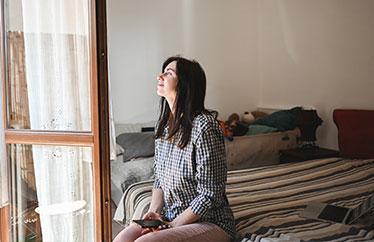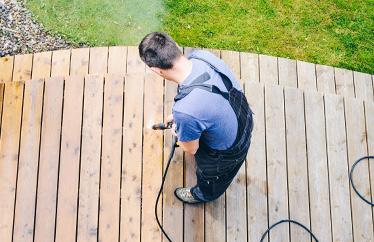How to Prepare For A Blizzard: The Ultimate Guide

Preparing for a blizzard includes gathering supplies such as food, water, warm clothes, flashlights and a source of heat to get through the storm in the event your power goes out or you become trapped in your home.
And while there’s no denying the magic of the first snowfall of the winter season, in Great Plain states like North Dakota, South Dakota and Minnesota, winter storms can take on a life of their own. The beauty can quickly turn into high winds, low visibility and piles of snow, making it dangerous to venture outside. And this severity is only getting worse due to climate change.
You likely have a lot of tools in your garage to deal with the snow, such as snow blowers, shovels and even roof rakes if you live in one of these states. But blizzards are more frequent and more damaging than ever before, occurring on average 13 times a year and causing approximately $12.6 million in damage per storm, according to a study by the American Meteorological Society.
Because of this increase in severity and occurrence, properly preparing for a major blizzard is more important than ever. Outside of collecting the right equipment, there are extra steps you need to take to ensure you can handle an impending storm.
Table of Contents:
What should you do before a blizzard?
Before a blizzard, make time to take the proper steps to prepare your home, car and family for what’s on the horizon. This means stocking up on supplies, putting together a car emergency kit, winterizing your home and gathering sources of light and heat, as well as creating an emergency plan for worst-case scenarios.
Below, we break down the ins and outs of each of these steps to help you and your family stay comfortable and safe throughout a blizzard or severe winter storm.
1. Stock up on supplies
When a blizzard hits, you can expect to spend a lot of time holed up indoors. Since hopping in your car and heading to the grocery store will likely be out of the question for a few days, it's critical to stock up on non-perishables and water ahead of time.
Add in a first aid kit and plenty of supplies that will help you stay warm, see in the dark and stay connected if the power goes out to create a well-rounded emergency kit to help you get through each and every storm.
- Batteries
- Battery-operated radio
- Battery packs for your phone or other devices
- Blankets
- Can opener
- Extra clothes
- Firewood (if you have an indoor fireplace)
- First aid kit
- Flashlights
- Matches
- Non-perishable food and water (three-day supply per person and pet)
- Paper towels
- Prescription medications
- Salt or sand for outside your home
- Space heater
- Toilet paper

2. Get your car ready to go
Though it's not recommended to drive during a blizzard, sometimes it’s necessary. Whether you’re heading to a shelter or going out for emergency services, you’ll thank yourself if you take the time to prepare your car before the storm.
To ensure your car is ready to drive in extreme conditions, keep your gas tank full, put on snow tires or snow chains and add an emergency kit to your car. Car emergency kits (as mentioned above) should include blankets, gloves, an ice scraper, flashlights, a shovel, safety cones and enough water and snacks for your entire family.
3. Winterize your home
Winterizing your home is especially significant since the outside of your home will bear the brunt of a blizzard’s dangerous effects. Not only will this help keep you and your family safer (and warm) inside, but it’ll also prevent you from having to pay for major repairs once the storm has come and gone. Our survey covering extreme weather impacts found that more than a quarter of U.S.-based homeowners spent more than $4,000 on emergency repairs.
Preventing winter damage includes taking steps such as wrapping your pipes, getting your HVAC system and fireplace inspected, sealing any exterior cracks, removing overhanging branches, adding in new weatherstripping to doors and windows, clearing out your rain gutters and removing all attached hoses from outside faucets.

4. Create an emergency plan
When disaster strikes, adrenaline can run high, meaning your decision-making skills might not be as sharp as they normally would be. That’s why creating an emergency plan is so essential, so you know exactly what to do next to keep your family free from harm no matter the situation. Whether a blizzard forces you to evacuate your home or the power goes out, leaving you stuck in a cold house, an emergency plan will break down the next steps for every scenario.
Wondering where to start when it comes to your family’s emergency plan? Check out our guide to building an emergency preparedness checklist for all the information you’ll need.
What to do during the storm
While there is a lot of information out there on what to do before and after a blizzard, you may be scratching your head when it comes to keeping everyone safe (and sane) while the storm rages outside your windows. To ensure your family has fun, stays out of harm's way and keeps warm throughout a blizzard, make sure to follow these tips:
- Stay indoors
- Wear multiple layers of loose, dry clothing
- If any of your clothing gets wet, change to dry clothes immediately to keep your body temperature high
- Drink plenty of water and eat warming foods
- If you must go outside:
- Wear snow boots, a hat, gloves and plenty of layers
- Watch for signs of hypothermia and frostbite
- Let someone know where you’re going and what time you’ll be back
- Take a fully charged cell phone with you
- While driving is not recommended during a blizzard, if you get stranded while driving, stay in your vehicle until help arrives
- For winter energy savings, lower the heat and close doors and vents in unused rooms.
- Play games, read books and do other low-energy activities to stave off boredom
What should you not do during a blizzard?
Now that you have a better understanding of what to do during a blizzard, it’s also necessary to take into consideration what not to do. To ensure no one in your household gets injured and that you all stay healthy and warm, make sure to follow these rules when a blizzard hits:
- Don’t drive during times of low visibility or in icy conditions
- Don’t go outside without checking your surroundings
- Look for patches of ice, downed trees or power lines and take each step slowly
- Don’t consume dehydrating drinks like coffee or alcohol
- Don’t shovel snow for long periods of time
- Take frequent breaks and wear layers of clothing to prevent frostbite
- Don’t use your back when shoveling snow to avoid injury
- Don’t heat your home with dangerous appliances
- This includes generators, charcoal grills or your stove

What should you do after a blizzard?
After the winds have died down and the snow is starting to melt, you may want to venture outside to assess the damage. But not so fast! While it’s necessary to check your home for external damage so you can alert your insurance provider, you first want to take care to protect yourself from the elements. This means layering up, shoveling snow and keeping a close eye on the icy patches below you and the tree limbs above you to keep yourself out of harm's way.
Once you gear up and are ready to go, complete a thorough inspection on the outside of your home. Make sure to note the following:
- Inspect your roof for fallen tree limbs, missing shingles or other damage.
- Test your fireplace and chimney, if you have one.
- Complete an exterior inspection of your home’s walls, looking for signs of water damage, cracks or holes.
- Turn your water back on and check the interior and exterior pipes for leaks.
- Check gutters and remove any debris.
- Inspect windows for small cracks that could lead to more significant issues down the line.
- Examine fencing and detached structures for damage.
- Go into all crawl spaces to ensure there are no water leaks or other issues.
If you find significant damage from water or the storm itself, make sure to take plenty of pictures. Then do your best to keep the damage from spreading and contact your insurance provider to submit a claim. They’ll get a professional out to your home to fix the damage and get your home back to its premium condition.

What to know about blizzards
As we saw in 2020 in Texas — thanks to climate change — winter storms can happen just about anywhere. But some areas are more prone to damaging blizzard conditions than others. The Great Plains and Upper Midwest regions are the most likely portions of the U.S. to experience devastating winter weather, though most states in the northern part of the country can (and often do) experience harsh winter weather every year.
A typical blizzard brings high winds, several feet of snow and freezing rain, all of which can damage property. In fact, according to the Insurance Information Institute, winter storms result in about $1.5 billion worth of insured loss every single year. The good news? Most winter storm damage is covered by insurance, so you don’t need to lose sleep about paying for the repairs yourself.

Similar to hurricanes and tornadoes, blizzard severity is rated on an official scale. But instead of focusing on the storm’s strength, the Northeast Snowfall Impact Scale (NESIS) rates a blizzard based on the number of people it’s estimated to affect. The five NESIS categories you need to know are 1. Notable, 2. Significant, 3. Major, 4. Crippling and 5. Extreme.
Additional winter storm prep resources
To learn more about how to prepare and recover from winter storms like blizzards, check out these resources from the government, The Weather Channel and other reputable programs.
- Winter Weather by Ready.gov
- Winter Storm Safety by The Red Cross
- Cold Weather Animal Safety by The American Veterinary Medical Association
- Winter Storm Resources by The National Child Trauma Stress Network
- Disasters and Your Family: Be Prepared by Healthchildren.org
- 14 Steps You Should Take to Prepare for a Winter Storm by The Weather Channel
- Prevent Hypothermia & Frostbite by The Center for Disease Control
- Winter Home Maintenance Checklist by Hippo
Home insurance and winter storm coverage
If your home gets damaged during a winter storm, don’t panic. After all, that’s why you bought home insurance, right? Your home insurance policy will likely cover damage from fallen trees, the weight of snow and ice as well as water leaks from burst pipes. However, not all policies are the same, so it’s vital to talk to your provider (or view your declaration page) to ensure you have the coverage you need before the winter season hits.
If you find you don’t have the coverage you need with your basic policy, consider adding on insurance riders to help fill the gap in your policy. Insurance riders like catastrophe insurance, umbrella insurance and hazard insurance are all good options to protect you financially from having to bear the brunt of the damage caused by blizzards.
No matter the storm or the damage, if you have a home insurance policy with Hippo, we’ve got your back. Learn more about how we can help you prepare for and rebuild from a blizzard by giving us a call.



